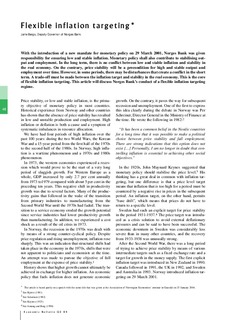| dc.contributor.author | Bergo, Jarle | |
| dc.date.accessioned | 2018-07-05T07:43:04Z | |
| dc.date.available | 2018-07-05T07:43:04Z | |
| dc.date.issued | 2004 | |
| dc.identifier.issn | 0029-1676 | |
| dc.identifier.uri | http://hdl.handle.net/11250/2504445 | |
| dc.description.abstract | With the introduction of a new mandate for monetary policy on 29 March 2001, Norges Bank was given responsibility for ensuring low and stable inflation. Monetary policy shall also contribute to stabilising output and employment. In the long term, there is no conflict between low and stable inflation and stability in the real economy. On the contrary, price stability will be a precondition for high and stable output and employment over time. However, in some periods, there may be disturbances that create a conflict in the short term. A trade-off must be made between the inflation target and stability in the real economy. This is the core of flexible inflation targeting. This article will discuss Norges Bank’s conduct of a flexible inflation targeting regime. | nb_NO |
| dc.language.iso | eng | nb_NO |
| dc.publisher | Norges Bank | nb_NO |
| dc.rights | Attribution-NonCommercial-NoDerivatives 4.0 Internasjonal | * |
| dc.rights.uri | http://creativecommons.org/licenses/by-nc-nd/4.0/deed.no | * |
| dc.title | Flexible Inflation Targeting | nb_NO |
| dc.type | Journal article | nb_NO |
| dc.subject.nsi | VDP::Samfunnsvitenskap: 200::Økonomi: 210::Samfunnsøkonomi: 212 | nb_NO |
| dc.source.pagenumber | 48-55 | nb_NO |
| dc.source.journal | Economic Bulletin | nb_NO |
| dc.source.issue | 2/2004 | nb_NO |

